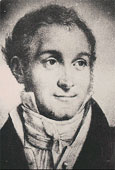Top Qs
Timeline
Chat
Perspective
Pierre Berthier
French geologist and mining engineer From Wikipedia, the free encyclopedia
Remove ads
Pierre Berthier (French pronunciation: [pjɛʁ bɛʁtje]; 3 July 1782, Nemours, Seine-et-Marne – 24 August 1861) was a French geologist and mining engineer.
Pierre Berthier was born in Nemours. After studying at the École Polytechnique, he went to the École des Mines, where he became chief of the laboratory in 1816. In 1821, while working in the village of Les Baux-de-Provence, in southern France, he discovered the rock bauxite,[1] named for the place of its discovery. He also discovered the mineral Berthierite, which was named after him. In addition to numerous contributions in mineralogy and mining, Berthier is also noted for his research into blast furnaces and for the utilization of phosphates by plants.
He was paralyzed by an accident in 1858.[2]
Remove ads
Awards
Pierre Berthier was elected a member of the Académie des Sciences in 1825. In 1828, he became a chevalier of the Legion of Honor. His name is one of the 72 names inscribed on the Eiffel Tower.[3]
References
Wikiwand - on
Seamless Wikipedia browsing. On steroids.
Remove ads

